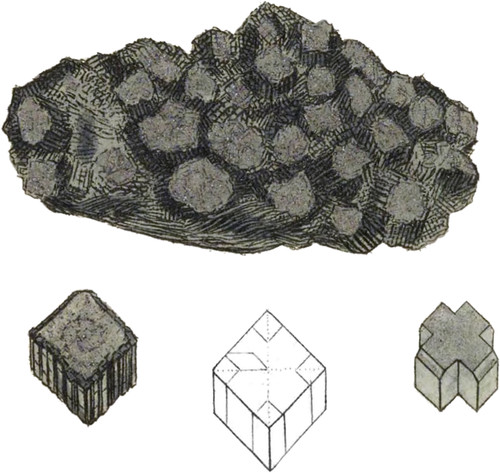 Enlarge
Enlarge
British Mineralogy
Sulphurated Cupreo-antimoniated Lead
- Class 3. Metals.
- Order 1 Homogeneous.
- Gen. 15. Lead.
- Spec. 3. Sulphuret of Lead.
- Syn.
- Triple Sulphuret of Lead, Antimony, and Copper. Bournon and Hatchett in Phil. Trans. 1804. Part I.
- Ore of Antimony. Rashleigh, v. 1. pl. 19.
This comes from Huel Boys in the parish of Endellion, in Cornwall, and has been always rare, and was supposed to be a Sulphuret of Antimony, until Mr. Hatchett analyzed a substance nearly related to it, but somewhat lighter-coloured, and found in the same mine—see pl. 136—which agrees with it in the nature of its crystallization, as is pointed out with much ingenuity by the Count de Bournon in the Philosophical Transactions.
They are found to be triple Sulphurets, and when most pure contain chiefly Lead, Antimony and Copper in the metallic state in union with Sulphur. Thus the whole becomes a cupreous antimoniated Galena, and, as most related to Lead Ore or Galena, we name it as above.
The present specimen is as it were passing into this triplet, as one of the common appearances of Sulphuret of Antimony is with it in the form of hairs and spiculæ, and the crystals are composed of, as it were, bundles of fibres, making a more or less complete modification, and accumulating in whorls or in crosses: see the right and left hand figures. The signs of the primitive cube are distinctly seen upon the ends of the groups, and the reverse of the same figure; but it is difficult to see the primitive fracture, as, although they have a loose appearance, they are so incorporated that they fracture most like a compact glassy substance, conchoidally and irregularly. We however had the luck to find one fractured face which may agree with the Count’s ideas. We have in this therefore the cubic sign of the primitive with the edges bevilled at an angle of 150° on the upper face, and of 120° on the prism, nearly as the Count de Bournon observes.

